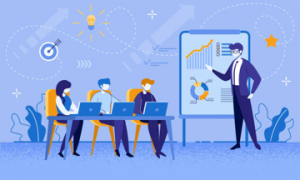With technology permeating every sphere of our daily lives in this global village of ours, digital literacy has become more important than ever in our work lives. The continuous digital transformations such as artificial intelligence, automation and digitisation that are going on in today’s workplace are tangible signs for the professional world.
According to the Cornell University, USA, digital literacy is the ability to find, evaluate, utilise and create information using digital technology. It includes areas like online security, and online communication responsibility.
In my own words I will say digital literacy is the ability to understand and use technology in a beneficial and useful way, noting the precautions and dangers that using technology requires as well as its limitations, and the confidence one has in using them. Getting your staff on the right digital track can seem to be a daunting task but it is very necessary as it fuels productivity, creativity, and growth.
Although digital literacy applies in all spheres of one’s life – at home, for your own hobbies, at school and in the workplace, many employees fall behind with their digital skills as digital literacy continues to evolve and grow.
It is for this reason that leaders must consciously work on improving the digital skills of employees regardless of the department they are in. It is likely that many will be able to use technology like mobile devices, computers social platforms and software for the purposes of communication, collaboration and more while others will need to be trained and educated more thoroughly to be able to adapt and easily implement tools or platforms.
Forbes reiterates that artificial intelligence and automation are fundamentally transforming the labour market, impacting all workers in all lines of work. In fact, the Metropolitan Policy programme at the Bookings Institution released a report earlier this year concluding that virtually all occupations will be affected by automation and artificial intelligence.
Change is already underway. Even jobs not traditionally seen as “technology jobs” today require some degree of digital literacy. Take, for instance, a mechanic – it used to be enough to know how to fix a busted engine, but today’s mechanics also need to understand the software and apps built into modern cars. As workers find themselves displaced by technology, or struggling to adapt, employers are having a difficult time finding the workforce they need to get ahead.
The latest Department of Labour report found 7.5 million jobs are currently unfilled in the U. S. – jobs that remain open while businesses fall short of growth plans and capable candidates sit on the sidelines. So where do we go from here? How do we prepare workers – both current and future – to secure good jobs and grow in today’s digital economy? And how do we help employers hire and retain qualified employees?

Instead of trying to predict what jobs of the future will look like, Forbes is urging employers, trainers, and workers to focus on the foundational skills that will be needed, namely digital literacy skills. These skills are increasingly important in today’s labour market and are key in the path forward. However, digital literacy training is not always easily accessible.
Costs, time constraints, and a basic lack of information about which skills are in demand and how to get training puts workers in a systematic disadvantage. Moreover, employers are still working through how to effectively identify, assess, and teach digital skills to workers. To navigate the movement toward digital literacy we urgently need to restructure how workers access training and education, as well as how employers account for skills in hiring and retraining qualified employees. Partnership across all players in the labour market – businesses, educators, career coaches and even policy makers – are paramount. We must recognise the diverse needs of these businesses and workers, and identify the most comprehensive ways to support them.
The need to equip workers with digital literacy skills and help them recognise and market the skills they already possess will most certainly boost productivity. Some organisations still act as though digital skills are only important for the IT department.
Times have changed though, and these skills are an essential part of managing your workforce. It is important to keep in mind that not every employee will bring the same level of digital literacy to the workplace.
Employers must thus proactively address the gaps after acknowledging them to avoid a steep change curve while achieving higher productivity and inclusion. Recognition of workers seeking to reskill through new training and education as not new recruits is very essential as many of them have years of experience in their field and limited time and resources.
They must be able to identify, compare and select the tools and sources of information that are best suited for their purpose. In today’s rapidly changing economy, new forms of accessible education and training are necessary with digital skills being inevitable no matter the path as running an efficient team without digitally literate employees is virtually impossible.
I always talk about digital footprint as one of the four dimensions of presence and engagement in my training sessions. This is one digital skill I teach trainees in terms of their online communication. Let’s take one aspect which is email etiquette. Emails are permanent records whose focus is to make the receiver’s work easier but never urgent because you do not know when it is going to be read. The nature of email demands that you always anticipate – The subject, greeting and signature are the tone setters in our emails. When it comes to emails:
- Greeting for business must err on the side of formality.
- You must create meaningful subject line by using key words.
- Anticipate questions and be clear in giving steps.
- Use bullets.
- Keep emails short.
- Use extra spacing and paragraphs.
- Be as descriptive as possible.
- Use ‘Please’ and ‘Thank you’
- Do not write what you believe is private.
- Do an assessment when Courtesy Copying (Cc) and use Blind Carbon Copy (Bcc) wisely.
- Do not do on email what you must do by phone. For example brainstorming, discussions etc.
- Read your email over word by word for grammar, and interpretation variation.
- Signature must also err on the side of formality.
This helps the receiver to have the information in the first point and makes the email memorable and easy to search. An important point to always remember is that emails are permanent but your emotions are not; so no matter how annoying the email may be, exercise emotional control and never reply an email when angry. Organisations and businesses must pay attention to these digital skills to keep from always apologising as it dents their reputation.

Here are four ways shared by everyonesocial to foster digital literacy and continue to keep up with the fast – moving and huge range of the digital landscape:
- Communicate the value and purpose
Do not assume everyone has the right digital skills or knows why it matters. Even though younger generations like Millennials and Gen Z have typically grown up with technology, it does not mean they value its benefits. Your organisation has to show employees why digital changes benefit them, like impacting their performance, increasing knowledge, and improving job productivity. Successful companies that ensure their digital workplace is strong, make digital skills part of their culture.
- Assess digital skills
There are periodic times where your company should be assessing the current levels of digital skills. This is not to scare employees or make them feel less valuable. It is to figure how to make your people more digitally aligned. Before you blindly offer training or support, your company must know what kind of levels of digital illiteracy workers might be facing. Your organisation can assess through surveys, simple digital tests or even opinion polls. There honestly is a lot you can – and should cover – like:
- Cyber security (spam, security risks, hacks)
- Digital collaboration (social media, digital tools)
- Ethics of being digital (data privacy, sharing information)
- Provide training and on-going support
Once your organisation evaluates and assess the digital skill of employees, this helps guide your company towards the right training and support. When your company offers these initiatives, it helps employees develop professionally and see that their company cares about nurturing their skills. However, when it comes to training, your company cannot just approach with one learning style. Similar to everyone’s unique digital skills, everyone also retains information and learns differently. Yes, it can get tricky, but if you blend the learning opportunities in different ways, results will be much stronger. What does this mean? Certainly offer some training sessions like a classroom setting, but add in visual learning (videos or presentations), online classes, let other employees become the teachers, bring in experts, 1 – 1 sessions, etc, combine different training and support or do them all.
- Measure and adjust as needed
Like any other strategy or tool, your company needs to measure the digital literacy in the workplace. Create a baseline measurement of the current digital skills, then use that to monitor progress, new growth, or any setbacks. This can help your team adjust to training or initiatives that are working or are not working.
Are you ready for TRANSFORMATION?
Dzigbordi K. Dosoo: The H.E.L.P. Coach
Dzigbordi K. Dosoo is a Soft Skills Expert, Personal Impact, Professional Growth and Influence Expert specializing in Humanness, Entrepreneurship, Leadership and Power – H.E.L.P.
A career spanning over two decades, she has established herself as a Certified High Performance Coach, Speaker, Author, Wellness Expert and award-winning Entrepreneur with a clientele ranging from C-Suite Executives, Senior Management, Practitioners and Sales Leaders spanning 3 continents.
She is the Soft Skills Expert and Founder of Dzigbordi K. Dosoo (DKD) Holdings; a premier lifestyle business group with brand subsidiaries that include Dzigbordi Consulting Group& Allure Africa.
Dzigbordi has been featured on CNN for her entrepreneurial expertise. She is one of the most decorated female entrepreneurs in Ghana having being named “CIMG Marketing Woman of the Year” in 2009; “Top 10 most respected CEOs in Ghana, 2012; Global Heart of Leadership Award and, Women Rising “100 Most Influential Ghanaian Women”, 2017.
She can be reached on [email protected] and @dzigbordikwaku across all social media platforms.










